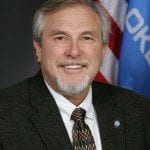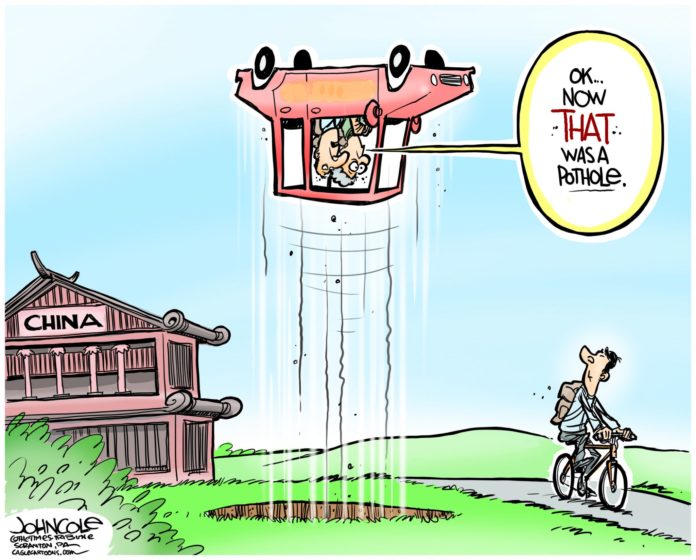BY DAVID PERRYMAN
 May 26, 2002 marked the most catastrophic bridge failure in the history of Oklahoma. Both lanes of a 580-foot section of the Arkansas River Bridge on Interstate 40 collapsed after a river barge crashed into a bridge pier. Fourteen people lost their lives when their vehicles plunged into the river.
May 26, 2002 marked the most catastrophic bridge failure in the history of Oklahoma. Both lanes of a 580-foot section of the Arkansas River Bridge on Interstate 40 collapsed after a river barge crashed into a bridge pier. Fourteen people lost their lives when their vehicles plunged into the river.
Today, many Oklahoma roads continue to be marked with signs like “Bridge Out” or “Road Closed.” Oklahoma has the fifth highest percentage of deficient bridges in the nation.
The problem is not new. A 1920s era photograph in the ODOT archives declared, “This Road Impassable to Keota.”
Ignoring the dictate of the Oklahoma Constitution, the Legislature delayed for years the establishment of a Department of Highway and, when it did comply, it failed to appropriate funds to run the agency. Then, when the Legislature passed a bill establishing a $1 per vehicle license fee to fund the Department of Highways, it did not establish a penalty for failure to pay the fee.
Since there was no record of the number of vehicles owned by Oklahomans, it is estimated that the owners of 60% of the state’s vehicles “chose not to participate” in remitting the fee to the state.
Funding remained a problem and, by 1920, there was still no viable state transportation network. The 1920 edition of the Official Automobile Blue Book – “the Standard Road Guide of America” – showed the best route from Oklahoma City to Dallas was via privately maintained roads through Durant in southeast Oklahoma. The route was described as “dirt and stony” and traversed 25-cent toll bridges over the South Canadian between Lexington and Purcell and over the Red River south of Durant.
Over time, two pubic road systems evolved in the state. One became known as the State Highway System and the other as the County Highway System. The State Highway System is comprised of 25% of the roads in Oklahoma and is funded largely by federal monies and legislative appropriations to ODOT. The funding to ODOT does not fund maintenance and operation of the 75% of the state roads that make up the County Road System. Consequently, maintenance of the 83,552 miles of county roads and bridges falls on the individual counties.
Each day school buses, oilfield trucks, agricultural vehicles and private cars drive 13.6 million miles over the County Road System. After decades of little or no funding, Oklahoma’s county roads and bridges had become a critical safety issue and rural Oklahoma roads were no longer able to serve the two most valuable economic sectors, agriculture and energy.
In 2006, Democratic Gov. Brad Henry signed a bipartisan bill creating and funding County Improvements for Roads and Bridges [CIRB] that directs that motor vehicle taxes be used for county road and bridge construction and maintenance.
As a result, counties have repaired or replaced hundreds of bridges and been able to leverage millions of dollars of federal funds for projects. In 2014 alone 96 rural bridges were repaired or replaced and 42 roadway projects were completed.
A unique component of the CIRB allows counties to plan for larger projects by collecting funds for up to five years. Currently, the projects in the five-year plan will cost $984 million and will go a long way toward repairing the 3,271 deficient county bridges and the 496 obsolete county bridges across the state.
Unfortunately, the state’s fiscal mismanagement over the past four years has been made worse by ill-advised tax cuts and runaway tax credits. The state is facing a budget gap of more than $633 million and instead of delaying another tax cut, Gov. and the budget chairmen in the House and Senate are talking about redirecting money from county roads and bridges and teacher retirement.
CIRB funding is essential to the counties that I represent and retirement system critics have been saying for seven years that the teacher retirement system is short on funds. Redirecting money from either of these funds to cure a self-made budget mess is a lose-lose proposition and will make the pathway to safe bridges and roads and better schools “impassible.”
– David Perryman, a Chickasha Democrat, represents District 56 in the Oklahoma House of Representatives








